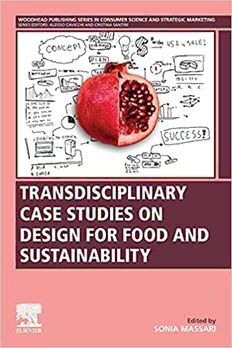
Transdisciplinary Case Studies on Design for Food and Sustainability PDF
Preview Transdisciplinary Case Studies on Design for Food and Sustainability
TRANSDISCIPLINARY CASE STUDIES ON DESIGN FOR FOOD AND SUSTAINABILITY Woodhead Publishing Series in Consumer Science and Strategic Marketing TRANSDISCIPLINARY CASE STUDIES ON DESIGN FOR FOOD AND SUSTAINABILITY Edited by SONIA MASSARI Roma Tre University, Rome, Italy ISIA Rome Design, Rome, Italy An imprint of Elsevier WoodheadPublishingisanimprintofElsevier TheOfficers’MessBusinessCentre,RoystonRoad,Duxford,CB224QH,UnitedKingdom 50HampshireStreet,5thFloor,Cambridge,MA02139,UnitedStates TheBoulevard,LangfordLane,Kidlington,OX51GB,UnitedKingdom Copyright©2021ElsevierInc.Allrightsreserved. Nopartofthispublicationmaybereproducedortransmittedinanyformorbyanymeans,electronic ormechanical,includingphotocopying,recording,oranyinformationstorageandretrievalsystem, withoutpermissioninwritingfromthepublisher.Detailsonhowtoseekpermission,further informationaboutthePublisher’spermissionspoliciesandourarrangementswithorganizationssuch astheCopyrightClearanceCenterandtheCopyrightLicensingAgency,canbefoundatourwebsite: www.elsevier.com/permissions. Thisbookandtheindividualcontributionscontainedinitareprotectedundercopyrightbythe Publisher(otherthanasmaybenotedherein). Notices Knowledgeandbestpracticeinthisfieldareconstantlychanging.Asnewresearchandexperience broadenourunderstanding,changesinresearchmethods,professionalpractices,ormedical treatmentmaybecomenecessary. Practitionersandresearchersmustalwaysrelyontheirownexperienceandknowledgeinevaluating andusinganyinformation,methods,compounds,orexperimentsdescribedherein.Inusingsuch informationormethodstheyshouldbemindfuloftheirownsafetyandthesafetyofothers,including partiesforwhomtheyhaveaprofessionalresponsibility. Tothefullestextentofthelaw,neitherthePublishernortheauthors,contributors,oreditors,assume anyliabilityforanyinjuryand/ordamagetopersonsorpropertyasamatterofproductsliability, negligenceorotherwise,orfromanyuseoroperationofanymethods,products,instructions,orideas containedinthematerialherein. LibraryofCongressCataloging-in-PublicationData AcatalogrecordforthisbookisavailablefromtheLibraryofCongress BritishLibraryCataloguing-in-PublicationData AcataloguerecordforthisbookisavailablefromtheBritishLibrary ISBN:978-0-12-817821-8(print) ISBN:978-0-12-817822-5(online) ForinformationonallWoodheadpublications visitourwebsiteathttps://www.elsevier.com/books-and-journals Publisher:CharlotteCockle AcquisitionsEditor:MeganR.Ball EditorialProjectManager:DevlinPerson ProductionProjectManager:AnithaSivaraj CoverDesigner:ChristianJ.Bilbow TypesetbySPiGlobal,India Dedication To Zoe, Vasco, and Elia: Help me to always see the future through a child’s eyes. Childrenarealwayslookingattheworldasifitwasforthefirsttimeintheirlives. So,weshouldalwayslooktotheworldwiththeeyesofachild.Iamnotsayingbe naive,Iamsayingbeinnocentinthesenseofdiscoveringthings. –PauloCoelho Contributors EmilyBallantyne-Brodie MagicalFarm,Hobart,TAS,Australia RicardoBonacho EstorilHigherInstituteforTourismandHotelStudies,Estoril;CIAUD—ResearchCentreforArchitecture, UrbanismandDesign,LisbonSchoolofArchitecture,UniversidadedeLisboa,Lisboa,Portugal JessCanose FoodStudies,FalkSchoolofSustainability&Environment,ChathamUniversity,Pittsburgh,PA,UnitedStates PaolaCarrabba Studies,AnalysisandEvaluationsUnit,ENEA,Rome,Italy AlessioCavicchi UniversityofMacerata,Macerata,Italy AngelaColucci REsilienceLAB;Co.O.Pe.Ra.Te.srl,Pavia,Italy MassimoCuratella SupportforDecision-Making—Facilitator,Rome,Italy JonathanDeutsch DepartmentofFoodandHospitalityManagement,CollegeofNursingandHealthProfessions,Drexel University,Philadelphia,PA,UnitedStates ErnestodiRenzo DepartmentofHistory,“TorVergata”University,Rome,Italy DentoniDomenico MontpellierBusinessSchool,MontpellierResearchinManagement,Montpellier,France FrancoFassio UniversityofGastronomicSciences,Pollenzo,Italy AllieviFrancesca JAMKUniversityofAppliedSciences,Jyv€askyl€a,Finland;BarillaCentreforFoodandNutrition,Parma,Italy RecanatiFrancesca BarillaCentreforFoodandNutrition,Parma,Italy BenjaminFulton DepartmentofFoodandHospitalityManagement,CollegeofNursingandHealthProfessions,Drexel University,Philadelphia,PA,UnitedStates LucioFumagalli NationalInstituteofRuralSociology(INSOR),Rome,Italy JudithGlover RoyalMelbourneInstituteofTechnology(RMIT),IndustrialDesignProgram,Melbourne,VIC,Australia MassimoIannetta BiotechnologiesandAgro-IndustryDivision,ENEA,Rome,Italy ColinJohnson SanFranciscoStateUniversity,SanFrancisco,CA,UnitedStates xv xvi Contributors Pila(cid:2)rLadislav DepartmentofManagement,FacultyofEconomicsandManagement,CzechUniversityofLifeSciences Prague,Prague,CzechRepublic GurpinderSinghLalli UniversityofWolverhampton,Wolverhampton,UnitedKingdom AdrianLebendiker UniversityofGeneralSarmiento,LosPolvorines,Argentina PatriziaMarti DepartmentofSocial,PoliticalandCognitiveSciences,UniversityofSiena,Siena,Italy Chalupova´ Martina DepartmentofManagement,FacultyofEconomicsandManagement,CzechUniversityofLifeSciences Prague,Prague,CzechRepublic SoniaMassari RomaTreUniversity;ISIARomeDesign,Rome,Italy KellyMcFarland MasterofScienceinAppliedAnthropology,UniversityofNorthTexas,Denton,TX,UnitedStates FabioPistella NationalResearchCouncil(CNR);Passinsieme,Rome,Italy AnnamariaRecupero DepartmentofSocial,PoliticalandCognitiveSciences,UniversityofSiena,Siena,Italy PedroReissig UniversityofBuenosAires,BuenosAires,Argentina AlexandraRomey DepartmentofFoodandHospitalityManagement,CollegeofNursingandHealthProfessions,Drexel University,Philadelphia,PA,UnitedStates LuigiRossi PresidentEmeritusItalianAssociationofGraduatesinAgricultureandForestry(FIDAF),Rome,Italy FabrizioRufo DepartmentofEnvironmentalBiology,SapienzaUniversityofRome,Rome,Italy CristinaSantini UniversitySanRaffaele,Rome,Italy PaolaSarcina MusicandTheatreInternational(M.Th.I.);CerealiaFestival,Rome,Italy HendrikN.J.Schifferstein DepartmentofHuman-CenteredDesign,DelftUniversityofTechnology,Delft,TheNetherlands LucioSepede Passinsieme,Rome,Italy LorenzaMariaSganzetta REsilienceLAB,Pavia;PolytechnicUniversityofMilan(PolitecnicodiMilano),DepartmentofArchitecture andUrbanStudies,Milan,Italy NancySnow OCADUniversity,Toronto,ON,Canada Contributors xvii AndreaSonnino ItalianAssociationofGraduatesinAgricultureandForestry(FIDAF),Rome,Italy Roj´ıkStanislav DepartmentofManagement,FacultyofEconomicsandManagement,CzechUniversityofLifeSciences Prague,Prague,CzechRepublic MarcoValentec SupportforDecision-Making—Facilitator,Malmo,Sweden MarialbaVentricelli DepartmentofEnvironmentalBiology,SapienzaUniversityofRome,Rome,Italy MandeeWieand DepartmentofFoodandHospitalityManagement,CollegeofNursingandHealthProfessions,Drexel University,Philadelphia,PA,UnitedStates PROLOGUE1 food | FUTURE | design SonjaStummererandMartinHablesreiter Honey&bunny Design follows sustainability? Over the past few decades, food design has established itself as a sep- arate area within the field of design. This subfield, though still quite small, existson theperimeters of theinternational designdiscoursebut continues togrow.Itsprotagonistsenjoyalotofmediaattention,withthespotlighton largeconferencestagesandincreasingacademicacceptance.Moreandmore renowneduniversitiesareestablishingfooddesignstudiesandcourses.Exhi- bitions, conferences, publications, and international networks emerge. In short, food design has transformed itself from a belittled curiosity into an aspiringdesigndiscipline.Itisprobablytheoldestdesigndisciplineinexis- tence and has now become a serious design field. Food design is booming. Thereisnolongeraquestionofwhetherornotfooddesignexists.Food designersnolongerneedtojustifytheirexistence,norwilltheyneedtowish for absolution of responsibility from design theorists. On the contrary, through our past work, we food designers have made it clear to the design worldthatthedesignoffood,alongwitharchitectureandfashion, belongs tothebasicdesigngenres.Justlikethedesignoflivingspaceorclothing,the designoffoodanddrinksalsoconcernsitselfwiththeculturalimplementa- tion of primary survival necessities. Food design is industrial design Foodisdesigned.Withtheexceptionofberriespickedinthejungleor mushroomscollectedintheforest,foodisprocessedandtreatedbyhumans; fromcultivationtoportioning.Designersareexcludedfromthemajorityof thesedesignprocesses,whichare,dependingoncultureandregion,consid- erablyindustrial.Inthemid-19thcentury,whentheworld’sfirstconveyor belt began to turn in Chicago, United States, there were no automobiles, tools,orothertechnicalconsumergoodsonit.Instead,itcarriedcattlehal- ves. The conveyor belt was developed for meat processing in the Chicago xix xx foodjFUTUREjdesign slaughterhouses,whichensuredaswellaspushedaheadthesupplyofmeatto the growing city. Todaywe mainlyeat “processed food,”meaning thatalmost everycal- orieweconsumehaspassedthroughoneormoreindustrialfacilities.Incon- trast to furniture, lamps, textiles, or shoes, most of which are still handcrafted, albeit more commonly in the Far East, food, as it is found in supermarkets, is mass produced and mass consumed. In the western indus- trial nations, we eat industrial design. Industrial food design is part of the Western, civilized life model. The belief in continued economic growth inevitably results in a continual increaseinsalesandthusinproduction.Theconstantavailabilityofallprod- uctsthattheglobalized"market"providesconsumerswithincludesalledible productsfor thewealthierpartof humanity.Thiscycleofmassproduction and mass consumption becomes visible in, for example, a supermarket: a grocerystorethatprovidesthesame,thoughseeminglyhuge,varietyoffood for those who can afford it every day of the year, every hour, and every- where. This oversupply of food is not tied to local or seasonal agricultural conditions on site. The globalized food market allows grapes, tomatoes, meat, and so on to be ready for sale any day of the year in as consistent a quantity and quality as possible. Grapes or tomatoes are always in season somewhere in the world, and if they are not in season in Central Europe, they are in Argentina or South Africa. As far as the quality is concerned, the origin of the food is as irrelevant as cultivation or working conditions, pollutionorsoilerosion.Thesupermarketistheexhibitionandretailspace ofanindustrializedandglobalizedfoodsupplysystemandakeydrivingforce behind this system is food design. Do we want to be industrial FOODdesigners? Unlikemostother(design)objects,foodisanindispensableitem.If,in times of overconsumption and hyperconsumption, the design legitimately questions what things people really need, food turns out to be one of the few items we actually need to survive. However, in Western countries, we are currently physically and psychologically further away from the sources of our calories (earth, water, and agriculture) than ever. Food is a consumer good that is available in abundance and it is treated as such. Up to30%offoodinEuropeisthrownawaysomewherebetweenproduction and consumption. foodjFUTUREjdesign xxi The question of daily nutrition is not only related to diets, recipes, or gourmet criticism, but also to effects on the ecosystem, as well as to social and economic processes. What and how we eat is directly linked to CO emissions,waterandlanduse,energy,andtransportsystems.Agricul- 2 ture as the production site of our food causes around 30% of global CO emissions and uses about 70% of the total fresh water supply. Against 2 these figures, it becomes clear why food waste, for instance, is not only a moral but also a very concrete, ecological problem. If we as food designers want to include sustainability in our work as a design parameter, we must fundamentally question the system of steady economic growth, overproduction, and mass consumption. Given the current social, political, economic, and ecological developments, our culture and our food culture in particular require reorientation. Hence, the connection between resource consumption and food production is clearlyaresultoftheincreasingworldpopulationaswellasrisingmeatcon- sumption.Additionally,economicgrowthpressureisleadingtoanincrease in production. Designisanexperiment,freethinking,andthefuture.Issuessuchascli- mate change, social inequalities, or waste production cannot be excluded fromareflecteddiscourseonfooddesign.Whiledesignerscontributedsig- nificantly to the digital revolution just a few years ago with their concepts and solutions, today they could support a trend toward a more conscious approachtojustice,fairness,resources,andpollution;inshort,a“sustainable revolution.” Asfooddesigners,wesitatthepivotofculture,interaction,andobject. Food design is the interface of different disciplines as well as the creative space between idea, production, market, and consumption. This is exactly where we have to deal with the handling of resources as well as unwanted sideeffects(externalities),laborrights,andtheincreasinginfluenceofdigital spaces. All of this requires joy in experimentation, transdisciplinary and international cooperation, and cooperation with science and research through design. Design is a powerful tool. We should be aware of that. And whichfieldof designwould bebettersuited toexperimentallydiscuss sustainabledesignthanfooddesign?Ouranswertothetheoreticalresearch and efforts to prove climate change, to explain refugee flows, or to justify ecologicalandsocialsustainabilityisthequestionofhowcreativeandinter- ventionist means can be used to initiate changes in behavior and mindsets toward food. It is not to the industry, but to the democratic society that we owe our thoughts, findings, and creations.
